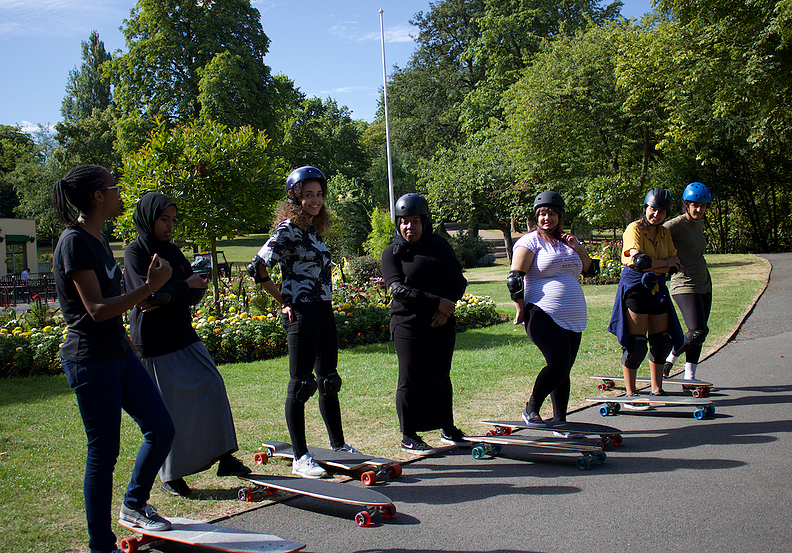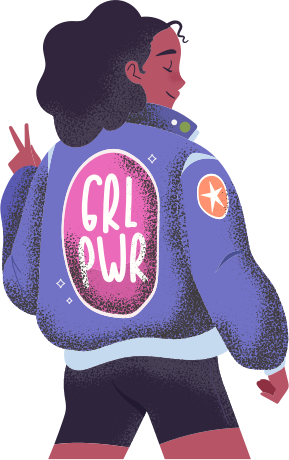Longboarding. That funny shaped surf board looking thing on land with wheels. Can’t quite figure it out sometimes. Looks like a skateboard, but it’s not. But that’s just ‘pintail’ longboarding. There’s many other styles. There’s even different styles of longboarding. You can cruise, dance and even downhill longboard… But what does all of this sport jargon have to do with us, female empowerment or social issues?
Well, when you combine a new sport to a city that desperately lacks new innovative things for young people to get involved with and then you make it exclusively for communities that get left-out of a lot of mainstream activities due to social, cultural, environmental and economic reasons – it becomes something magical.
We call it ‘Boarders Without Borders’.

Some of our second cohort of longboarders.
Boarders Without Borders is an initiative we set up last summer in 2017. It was a project that started with our Co-Founder, Amna, longboarding around four years ago but was pretty much one of the first female and definitely first brown girl in the city to own one. It meant she cruised around the streets and parks on her own and the only other skating groups where around skateparks and with predominately white dudes. By setting this up as a way to use sport as a tool for social change, we ended up creating the UK’s first women of colour longboarding crew. Or skate crew for that matter. Or people of colour for that matter. Maybe Europe too? We’ll get on trying to confirm that! We’re now on our second year with a whole new crew! But of course, this type of sport is mainly associated with the typical “skater dude” image and that “dude” just happens to be white a lot of the time. For longboarding, there’s a strong rise of women taking on the sport with movements like Longboard Girls Crew and Skateistan (check them both out, they’re awesome) but something was still missing for us.
When we type into Google images “longboarding” we get images like this:

If we type in “longboarding women” or “female longboarders” there’s images like this:

There’s no disrespect for these boarders because they’re amazing and work really hard at the sport they love. This blog isn’t about bashing white longboarders to raise the profile of people of colour. It’s to shine a light of the empowering effects longboarding has on other communities besides the social norms because it’s about way more than a sport for certain communities. Here’s a few things we’ve learned from creating this initiative:
1. Longboarding has transferable skills for every day life. When you’re cruising on a longboard, you’re mindful. You’re literally at one with your board and you’re doing your thing. However, before you get to that stage you quickly realise what kind of person you are to how you start your longboarding journey. Over-thinkers, those more hesitant about decision making and those who are more self-conscious take to longboarding at a slower pace because there’s a whole world of thoughts and anxiety-inducing steps that happen before you feel comfortable on the board. Chillers, easy going folk and don’t take life too seriously type of people literally get up and go on the boards. However, understanding this about yourself and how other people approach situations when in a longboarding crew makes you adapt a broader understanding of how people approach life situations. When you’re all together with your crew – you become a support network and you move as one. You make sure no-one is left behind, you don’t laugh if someone falls because that’s progress and you celebrate how each individual comes from a different walk of life because your crew has no one way to be. How beautiful would it be to translate these skills and understanding of yourself and people you learn from boarding into your home or work life?
2. Longboarding celebrates individuality. Unlike certain water sports, rugby, football, cricket baseball and basketball – skating tends to have a “come as you feel” vibe. There is of course that classic baggy-everything skater look or the new Pinterest style of female longboarders which tends to be swimwear, shorts, skirts, hoodies or anything that makes you feel comfortable depending on where you live and your personal preference. For many of the boarders we engage with, the beauty comes in something that many sports make less accessible for certain communities – the dress code. There is none. So in our crews, we have boarders who wear shorts and a t-shirt, who are all about jeans and skater long socks, a hijab and jeans or a hijab with a long skirt, leggings with a top and of course, hoodies. We live in England after all. Regardless of your religious or cultural or simply preference status, you are welcome because as long as that footwear is good – you’re good to go! My hair and religious wear was an issue in school during P.E lessons, but with longboarding – I can just be. Because you can board together or you can board alone. With short hair, long hair, afro, braids, shaved hair, hijab or turban to cover your head or baseball cap or beanie for your own style. Individuality is what makes the sport so accessible and for people of colour, that’s a huge thing. In workplaces, social environments and even school – our expression of culture in how we dress or present ourselves is not always accepted.
3. Longboarding can be inexpensive. Let’s face it, being a part of a tennis club or many sporting clubs for that matter, requires money. Lots of it too. Many people of colour in many cities live disproportionately in the “under-developed”, “disadvantaged”, “deprived”, “low socio-economic” areas. This means many young people, especially in Birmingham (as we can speak from first hand experience), do not grow up taking part in extra-curricular activities because they cost or are simply not prioritised for many reasons. Sport is definitely bumped to the back because education comes first. Always. Therefore, it’s no wonder communities like the south Asian community are the least active in the UK and people of colour have the least engagement rate in sport overall in the UK. There are obviously other factors but socio-economic reasons are definitely up there. To maintain your child’s interest in sports means having to regularly take them to a club so keeping in mind transport methods and time/commitment, pay for them to upkeep those lessons and keep up every time a new piece of equipment, uniform or travel to compete in another city or country comes up. Not everyone can do that and for many of the communities we serve, this is not an option much of the time. Therefore, longboarding is a simple, inexpensive and easy option to get you going in sport and in a new activity. You can indepdently learn from YouTube or just exploring the board itself, you do not need any uniform or to become a part of any paying club – you rock up to a free park or your road and you ride. There’s an extra level safety in knowing as a parent/guardian that your child can be nearby your home but still doing their hobby. Speaking of safety, safety gear is always a good option and again, it’s not too expensive. It means you can do it in your own time, learn with friends and keep your cost low to fit your current circumstances.
We’re going to leave the reasons at that for now because what we want is to spark an interest and understanding of how a seemingly “just for fun” sport can lead to powerful changes and moves in social mobility. Longboarding is also a fun, relatable, relevant way to engage the younger generation who find it more difficult to find things that interest them and find activities that happen in sunny California or Hawaii and usually by people they can’t not relate to right here in their grey, urbanised city. But what if people, companies, brands invested in organisations like us (and many others) that are using this very relevant, millennial, Instagrammable way of interacting and engaging with young people to build skills like self-confidence and socialising in-person, reduce stress and anxiety, mindfulness, trust, risk taking, support, physical and mental growth, facing challenges and being pushed outside of your comfort zone.
What if we recognise that learning, growth, social mobility, social circumstances and social stigmas can be address not through the luncheons, business networking events and a funder-led ‘lets hear from everyone but those who have lived experience’ fundraisers and get-togethers. They’re outdated, they’re irrelevant and they do not engage on a ground level with those FROM the communities who could do with some of this supposed support. Getting more well versed in culture, social status, inequality, representation and inclusion is no easy task if this isn’t the world you grew up in, luckily for you – we did. We know how and why this works. We know why we have more demand that we can fulfil because we receive no support from our city. We all volunteer so that girls and young women of colour in OUR city can turn to something and someone who they can relate to and engage with and feel good for those two hours a week when we meet up and can hopefully take that into other areas of their lives.
Invest, sponsor, donate – email us at hey@girldreamer.co.uk and let’s see how we can take this sport to new heights and tackle many issues that many cities face through a unique lens. We must warn you, this requires some open-minded thinking and a new approach at growth. Hit us up if you dare.
Stay hydrated, stay gnarly!




